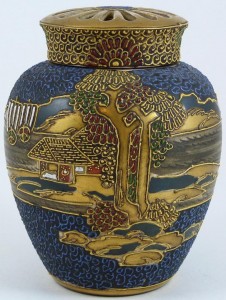Moriage is the term used to describe the fine and delicate layering or placing of clay on pieces of pottery
The type clay that is used for this method is known as "slip" and is thicker and stickier than the clay used for the actual item
The Japanese potters of centuries ago were enthused with this method and used it to create many brilliant designs over the years
In the case of Satsuma pottery, the clay was often added in small bumps, circles or lumps to decorate the piece.
On a satsuma vase
These are the
It is also possible that the
Beading is also used quite heavily on this style of pottery too, with small dots of clay added to make raised bumps that are then painted when the piece has been fired and completed. These raised areas on the pottery add to the overall design, making them more decorative and unique, compared to just a painted piece.
The combination of hand-painted designs,
Other types of pottery from Japan also used this method of decoration too. Dragonware pottery is famed for it's intricate dragon designs that stand up and are raised from the piece, all classed as
The shame about this kind of decoration is that it can be easily damaged over time and break off. Also some of the paint-work, gilding or colour can rub off if the pieces are not kept in good condition.
 |
As an eBay Partner, I may be compensated if you make a purchase
As an eBay Partner, I may be compensated if you make a purchase
As an eBay Partner, I may be compensated if you make a purchase










7 replies on “Antique Japanese Moriage”
Hello! I have been trying to find the history about the candy jar or whatever it is. I can’t find anything even close
I have two satsuma vases need info on them
mark pictured
Vase pictured below is marked (by hand) on the bottom with three red parallel lines, the third one curving outward at the top…maybe a Japanese character?
Hello, I have a similar style and decorated vase, also has those 3 finger type indentations around bottom. We’re you able to find any info about yours? I’d be interested.
Thanks,
Mrs. Owens
Is this moriage? Thank you.
looking to find info about a vase i have